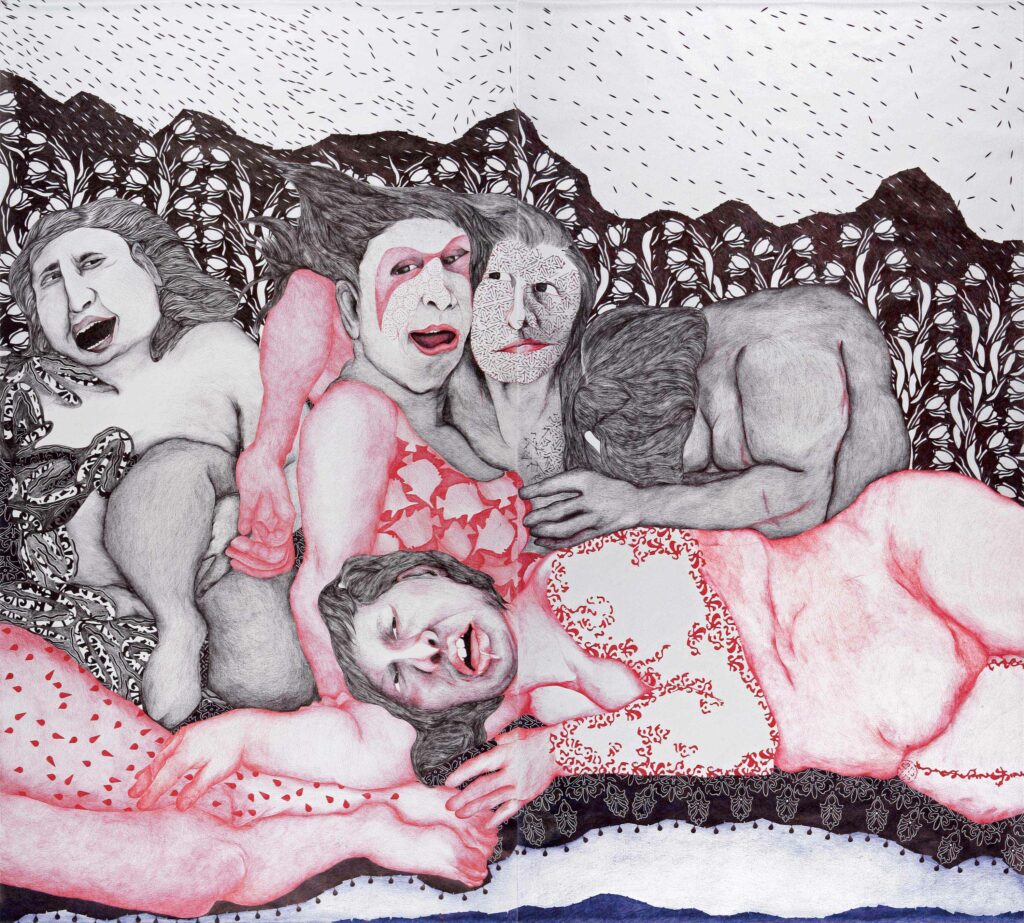“Kiss ko pyaar karoon, kaise pyaar karoon, tub hi hai, yeh bhi hai, woh bhi hai….hai!” A gold sequined Shammi Kapoor lookalike burst on the stage with a bang and thus began Tape – India’s first drag king show. Funny, poignant, cool and above all celebratory, this was fierce and unapologetic theatre, written and directed by Vikram Phukan, and produced as a joint effort of the Patchwork Ensemble theatre group, the Gaysi Family community organization and artist Sharmistha Ray’s Bellevue Salons. Structured as a play within a play and set in a fantasy Mumbai where drag king performances are the norm, Tape had Puja Sarup channeling Shammi Kapoor and Sheena Khalid as Justin Timberlake, with a supporting cast of other fantastic characters like a raunchy Mr. 55 (Ratnabali), and the crowd favourite, Harpal Singh (Mukti Mohan).
We’ve had drag in India forever – whether in our mythological stories, in folk traditions, or even in Bollywood, but it’s mostly been men dressed up as women and not the other way round. Women – performing masculinity – overtly and flamboyantly – have been rather invisible. Tape was an attempt to address this imbalance. The title refers to something that many, but not all drag kings do before they get on stage – they tape their breasts to flatten them. The play dealt with this activity – an act of personal politics – as it did with many other aspects of gender, societal expectations, conformity and performativity, but it did so with such a light and fabulous touch, that it never felt heavy or preachy. I just couldn’t stop smiling, non-stop.
In any case, I was in a really good mood after having attended Lakme Fashion Week. Just like with Tape, here too, questions about gender, beauty and performativity had been raised. What! You must be wondering – a fashion week questioning ideas of beauty? Isn’t a fashion week all about reinforcing stereotypes? Well, not this one for sure!
Consider Eina Ahluwalia’s conceptual jewelry installation titled Pilgrimage. The first part of the installation comprised of a walk-through between gold statues of big-bodied Venus figures, inspired from ancient times. At the base of each figure, Eina had piled up an array of objects – ranging from hair removal creams, tweezers, razors, make-up, ridiculously high heels, candles and flowers. Each arrangement was both – a shrine to an alternative idea of beauty as well as a scathing commentary on conformist beauty ideals in today’s world.
The second part of the installation had us walk past 12 seated models wearing Eina Ahluwalia jewelry. As I passed them, they began to look at me from top to bottom and whisper comments to each other about my appearance. It wasn’t a very pleasant feeling I must say, even though I’m quite used to people checking me out by now.
The third part of the installation comprised a line of hanging mirrors with words like ‘beauty filters’ painted on to them. The irony of posing in front of these, and uploading images to Instagram was evident, but the urge was too compelling not to. Finally, as the last part of the exhibit, I wore headphones and listed to the mythological Sirena whisper ‘you are perfect’ in different modulated voices to me while viewing a digital screen with different versions of Eina’s Photoshopped face.
By the time I walked out through the exit, I had tears in my eyes. “There can never be one fixed idea of what is beautiful, and instead of chasing ever-transient, impossible ideals, we need to find a comfortable acceptance of our own perfection,” Eina told us with a big smile outside, and I couldn’t agree more.
Eina’s installation actually reminded me very much of artist Vidha Saumya’s work, on display at Mumbai’s Gallery Mirchandani Steinrucke. Vidha’s 2011 Love Charades at the same gallery featured spot-lit corpulent women laughing while contorting their body within circus rings. Later for the Touched by Bhupen tribute there, she created large faced women with names of recent hurricanes, sneezing passionately. Now as part of the Body as Site exhibition, Vidha’s women create mesmerizing Messes of the Afternoon.
The title refers to an experimental homemade film Meshes of the Afternoon (from 1943) which combined the surreal and mundane wonderfully. Vidha’s works are very much a combination of both these elements. In this series of seven large format drawings, again done entirely with Cello gripper pens in her signature style, there is more fluidity, more in-between-ness. The big-bodied women sometimes flow into big bodied men, and in many cases, we can’t tell who is what, but it doesn’t matter. Each act in Vidha’s work – whether of feeding, whispering, or embracing, is both intensely private and extremely public and by viewing these gender-fluid bodies on an imaginary still afternoon, we are forced to confront our own internalized notions of beauty, and indeed, patriarchy and societal norms.
*This blog post is a modified version of my column ‘Parmesh’s Viewfinder’ that appears monthly in Verve magazine.

